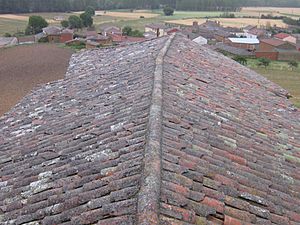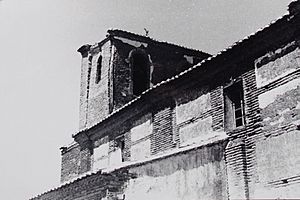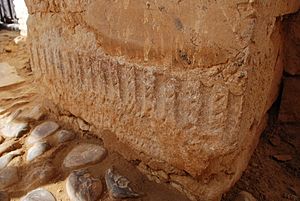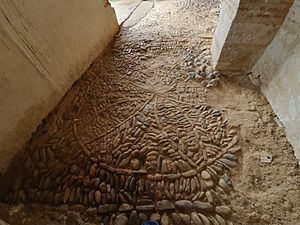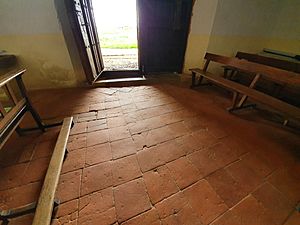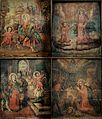Church of Our Lady of the Assumption, Villamelendro de Valdavia facts for kids
Quick facts for kids Church of Our Lady of the Assumption |
|
|---|---|
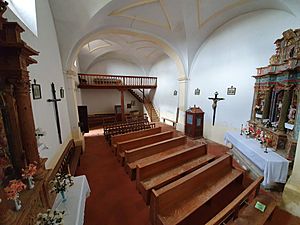
Interior
|
|
| Lua error in Module:Coordinates at line 614: attempt to index field 'wikibase' (a nil value). | |
| Location | Villamelendro de Valdavia |
| Country | Spain |
| Denomination | Catholic Church |
| History | |
| Status | Active |
| Dedication | Assumption of Mary and Saint Rocco |
| Architecture | |
| Functional status | Parish church |
| Architect(s) | Juan de la Cuesta |
| Style | Baroque architecture |
| Administration | |
| Diocese | Palencia |
The Church of Our Lady of the Assumption is a beautiful Catholic church in Villamelendro de Valdavia, Spain. It was first built a very long time ago, in the early 1100s. The church has a special design called Baroque style.
Contents
History of the Church
This church has been around since the 1100s. We know this because of old records from 1180. In that year, Alfonso VIII, a king, officially recognized the communities of Villasila and Villamelendro.
The church you see today was built on top of an even older building. The front part of the church, called the presbytery, is a bit different from the rest. It's thought to be the oldest section. This is because it was closer to the village and was the most sacred area.
Building the Church
Records from 1549 show that a lot of building work was happening. Most of the church we see now was built by a master stonemason named Juan de la Cuesta. He was from Cantabria.
Juan de la Cuesta worked with Pedro de Argadero. Pedro was from Carrión de los Condes. He helped build the wooden frame that supports the roof. Later, parts like the entrance porch and its floor were added. Some buttresses and the sacristy were also changed after Juan de la Cuesta's main work.
Old Traditions
Until the late 1980s, there were special seating arrangements inside the church. Men usually sat in the choir area or near the entrance. Women sat closer to the front, near the presbytery.
These special kneeling spots for women were often above where their family members were buried. Families would keep the same seating area for generations.
Church Architecture
Outside the Church
The church is made of brick and stone. It has a modern bell tower at the front. This new tower was built in the mid-1900s. It replaced an older, unstable tower.
You enter the church through a church porch on the right side. This porch was used for storage for a while. In 2012, it was restored. During this work, workers found old skulls. These were from people buried outside the church long ago.
The main outside door has two large panels. There's also a smaller door inside for quick entry. In 2014, this door was restored to work properly again. They removed many layers of old paint. They found grey, light green, light brown, and dark brown paint. During the restoration, two pattée crosses were found carved on the left door.
A special carved stone was also found during renovations. It had been moved from its original spot. Experts say its grooves are from the Renaissance period. There are 15 grooves, each ending in a semicircle.
On the outside of the sacristy, there's a relief of a pattée cross. This cross design is seen on many doorways in the region. It might have been a way to protect against diseases, like the cholera epidemic in 1855. It could also be linked to a local brotherhood called the Vera Cruz.
There's a reddish brick on the outside of the apse. Locals call it the santo rojo (holy red). It acted like a sundial in summer. Its shadow would reach this brick at noon, helping people working nearby know the time.
The cemetery is on the north side of the church. It was probably built in the early 1800s. The current cemetery is an expansion of the original one.
Inside the Church
The inside of the church has one main room and a presbytery. These are separated by stone arches. The ceiling is a barrel vault, and there's a wooden choir at the back.
In 1987, old paintings from the 1700s were found inside. On the left side of the entrance, there's a star pattern on the floor. On the right, there's a design of a vase, which represents the Virgin Mary.
During the 2012 renovation, parts of the floor were found to be made of small river rocks. These rocks form patterns. A pattern near the entrance might be a sun symbol. These symbols were often placed at church entrances for protection.
The main church floor still has its original terracotta tiles. For many years, people were buried under the church floor. Because of this, many tiles are now dented or chipped. Wealthier people could pay to be buried closer to the altar. As space ran out, an outside cemetery became necessary in the 1700s. However, burials inside continued until the 1800s.
Fixtures and Decorations
At the very front of the church, in the presbytery, is the main altarpiece. It was made in the early 1600s. It shows paintings of the Annunciation and Adoration of the Shepherds.
Around these paintings are four smaller panels. They show important figures called the Fathers of the Church: Augustine of Hippo, Gregory the Great, Ambrose of Milan, and Jerome of Stridon. These figures are like the pillars of the Church.
In the center of the altarpiece is a niche with an image of the Ascension. Around it are four panels showing the life and martyrdom of Cyricus and Julitta. A crucifix sits above the altar.
On the right side of the church, there's a rococo altarpiece. It has reliefs of souls and the Holy Trinity. On the other side, there's another crucifix and a similar rococo altarpiece, but with gold reliefs.
The door of the main room has a relief of the Resurrection. In the baptistery, behind the choir, there's a baptismal font. It has a pattée cross carved on one side. This font is thought to be from the late 1700s.
The church also has other interesting artworks. One is a picture of the Sacred Heart of Jesus. It was given to the church in the early 1900s. A family donated it when their son, Marcos Cabezón, returned safely from the Third Carlist War.
There are two large religious banners. One is used for holidays. It has three stripes: two crimson and one white in the middle with a crimson cross. The other banner is purple with gold trim. It's used for burials and Passion celebrations. Both banners are carried with a bronze processional cross and two lanterns from the 1700s.
Conservation and Restoration
The church built by Juan de la Cuesta had some problems early on. They had to add buttresses to support the walls. The area near the apse also needed strong buttresses.
In the cemetery area, the base of these buttresses has been damaged by moisture and burials. This leaves the building less protected. In the mid-1900s, the arch of the presbytery was reinforced to make it more stable. However, another arch in the main room is still moving inwards. This could damage the second vault.
Also, in the late 1900s, the base of the church was painted with plastic paint. This caused moisture to get trapped in the walls, making them weaker. Because of these issues, the church was added to the "Red List" of endangered heritage sites in November 2019. This list is managed by an organization called Hispania Nostra.
See also
 In Spanish: Iglesia de Nuestra Señora de la Asunción (Villamelendro de Valdavia) para niños
In Spanish: Iglesia de Nuestra Señora de la Asunción (Villamelendro de Valdavia) para niños


